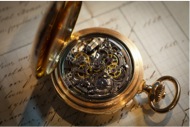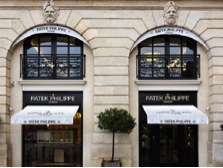The history of the Patek Philippe watch
Patek Philippe & Co. was founded in 1851 in Geneva and the Vallee de Joux by Antoni Patek and Adrian Philippe. It is considered by many experts as one of the most prestigious watch brands in the world. And counts Pope Pius IX, Queen Victoria, Victor Emanual III of Italy and Christian IX of Denmark as past owners of a Patek Philippe watch.
Antoni Patek was a Polish watchmaker and in 1845 joined French watchmaker Philippe who was the inventor of the key-less winding mechanism, and so Patek Philippe was born.
 In 1976 the Patek Philippe introduced the Nautilus collection after deciding it was time to produce an exclusive watch with the highest finishes, while refreshing the brand image. Patek Philippe pioneers the perpetual calendar, split-seconds hand, chronograph and the minute repeater in watches. And this is why Patek is notable for manufacturing its own watch components. They make mostly mechanical movements but have produced quartz watches in the past along with a digital wristwatch (Ref. 3414).
In 1976 the Patek Philippe introduced the Nautilus collection after deciding it was time to produce an exclusive watch with the highest finishes, while refreshing the brand image. Patek Philippe pioneers the perpetual calendar, split-seconds hand, chronograph and the minute repeater in watches. And this is why Patek is notable for manufacturing its own watch components. They make mostly mechanical movements but have produced quartz watches in the past along with a digital wristwatch (Ref. 3414).
Due to Patek making their own components their watches record high auction prices worldwide and bring in a large crowd. This is partly due to Patek themselves, as they are know to buy back watches to add to their own collection in their museum in Geneva. It is not known exactly how many Patek make a year but in 2010 they produced only 40,000 watches and in 2012 they produced 50,000.
The company has always been a privately run establishment. And has been owned by the Stern family since 1932, and as of the late 2000’s it was led by Philippe Stern and his son Thierry Stern who took over from his father in 2010.
 The way a Patek Philippe watch is made is quite a guarded secret but what is known to the public illustrates how difficult it truly is to make one of these timepieces. The colour of the dial is a science. Patek employs an expert chemist and only a few exist at his level. He can have up to four variations of colour in his baths depending on the time of day and humidity, so he has to constantly adjust because the slightest difference would make people go crazy trying to buy on for the rarity, so it is crucial that all the dials are exact. The process itself has between 50 to 100 steps to produce the average dial and there are between 12 to 20 bath treatments. The aforementioned Nautilus takes a tremendous amount of time to make, with all the bracelets being hand polished and each link is cut out one at a time taking seven minutes per link to cut and it is then hand assembled taking a whopping seven hours to hand polish one complete bracelet. And if you thought it got easier from there it doesn’t! The movement within the production of a single movement can require the expertise of highly skilled individuals, involving 1,200 to 1,500 individual steps. The company allows its employees to have full freedom to make their own models and to prepare different models right from the company’s on-site factory.
The way a Patek Philippe watch is made is quite a guarded secret but what is known to the public illustrates how difficult it truly is to make one of these timepieces. The colour of the dial is a science. Patek employs an expert chemist and only a few exist at his level. He can have up to four variations of colour in his baths depending on the time of day and humidity, so he has to constantly adjust because the slightest difference would make people go crazy trying to buy on for the rarity, so it is crucial that all the dials are exact. The process itself has between 50 to 100 steps to produce the average dial and there are between 12 to 20 bath treatments. The aforementioned Nautilus takes a tremendous amount of time to make, with all the bracelets being hand polished and each link is cut out one at a time taking seven minutes per link to cut and it is then hand assembled taking a whopping seven hours to hand polish one complete bracelet. And if you thought it got easier from there it doesn’t! The movement within the production of a single movement can require the expertise of highly skilled individuals, involving 1,200 to 1,500 individual steps. The company allows its employees to have full freedom to make their own models and to prepare different models right from the company’s on-site factory.
Patek don’t rush to production either, it takes three to five years of research to develop a new model. This is why Patek Philippe are one of the world’s most prominent companies in the world of luxury and have the price tag to go along with it. The majority of the watches on sale go for at least £10,000 and these feature fine metals and have unique appearances. A ‘basic’ Golden Ellipse watch, which is made from rose gold materials, can go for above £16,500 and the completely gold bracelets go for above £30,000.
Written by Benjamin Dyson
